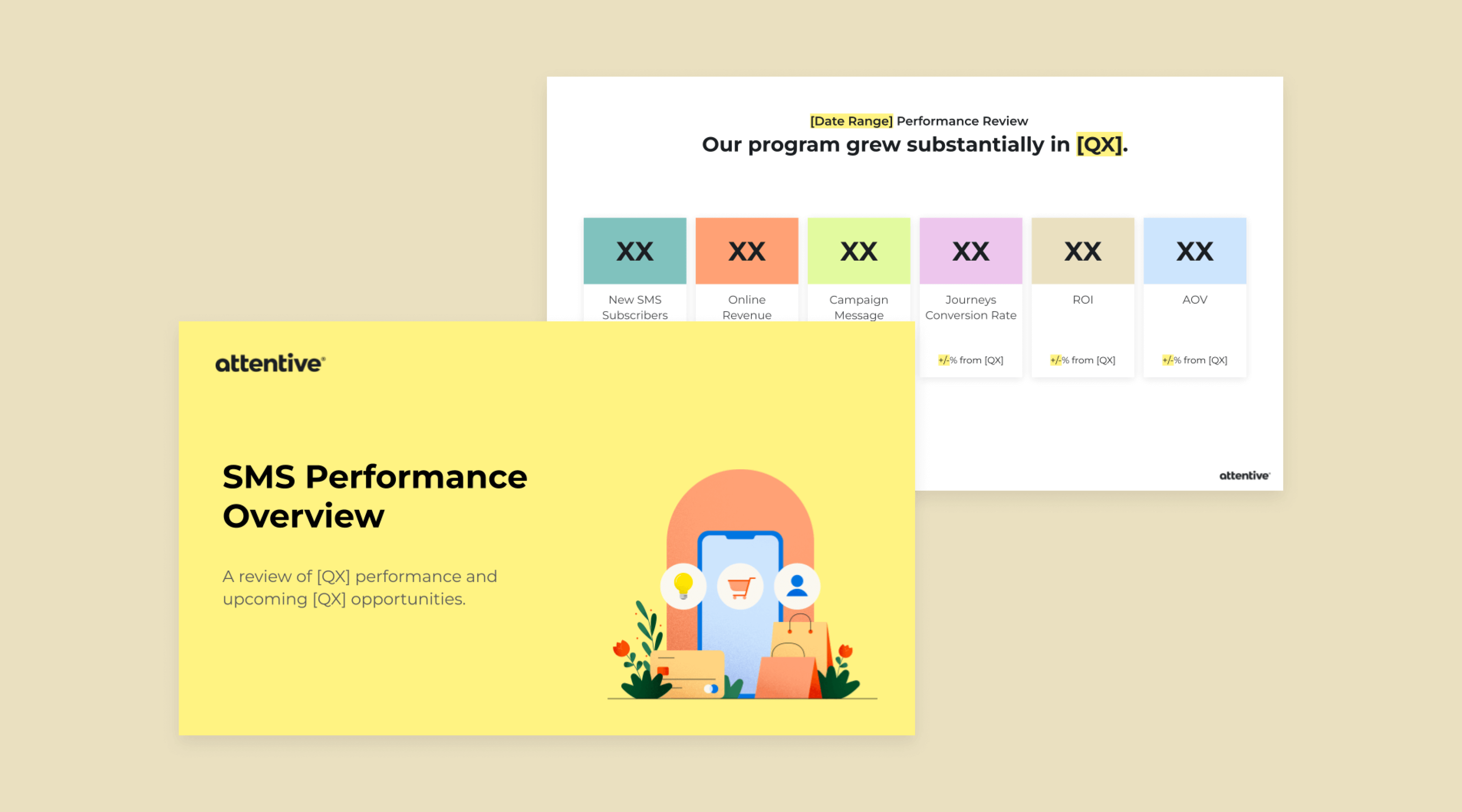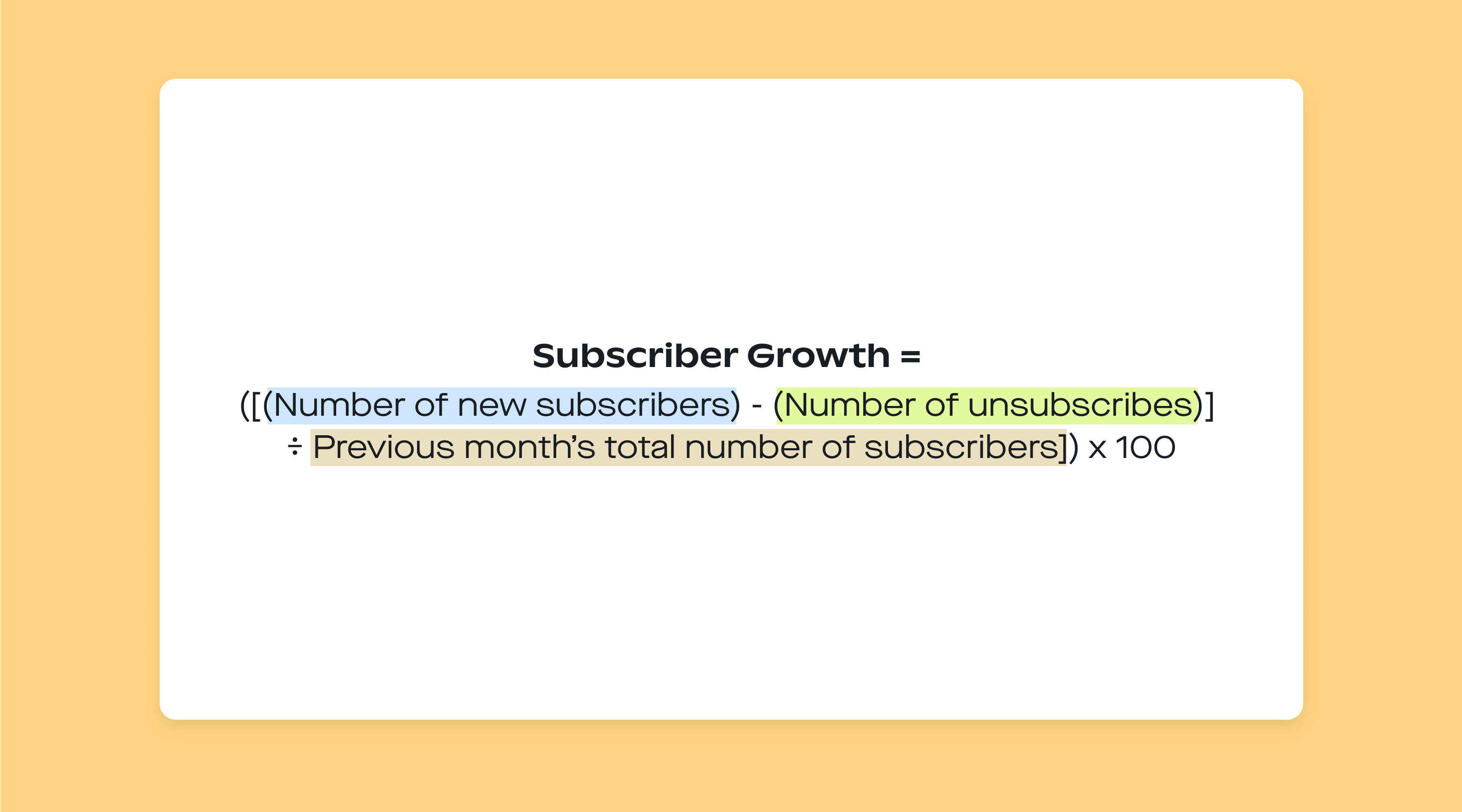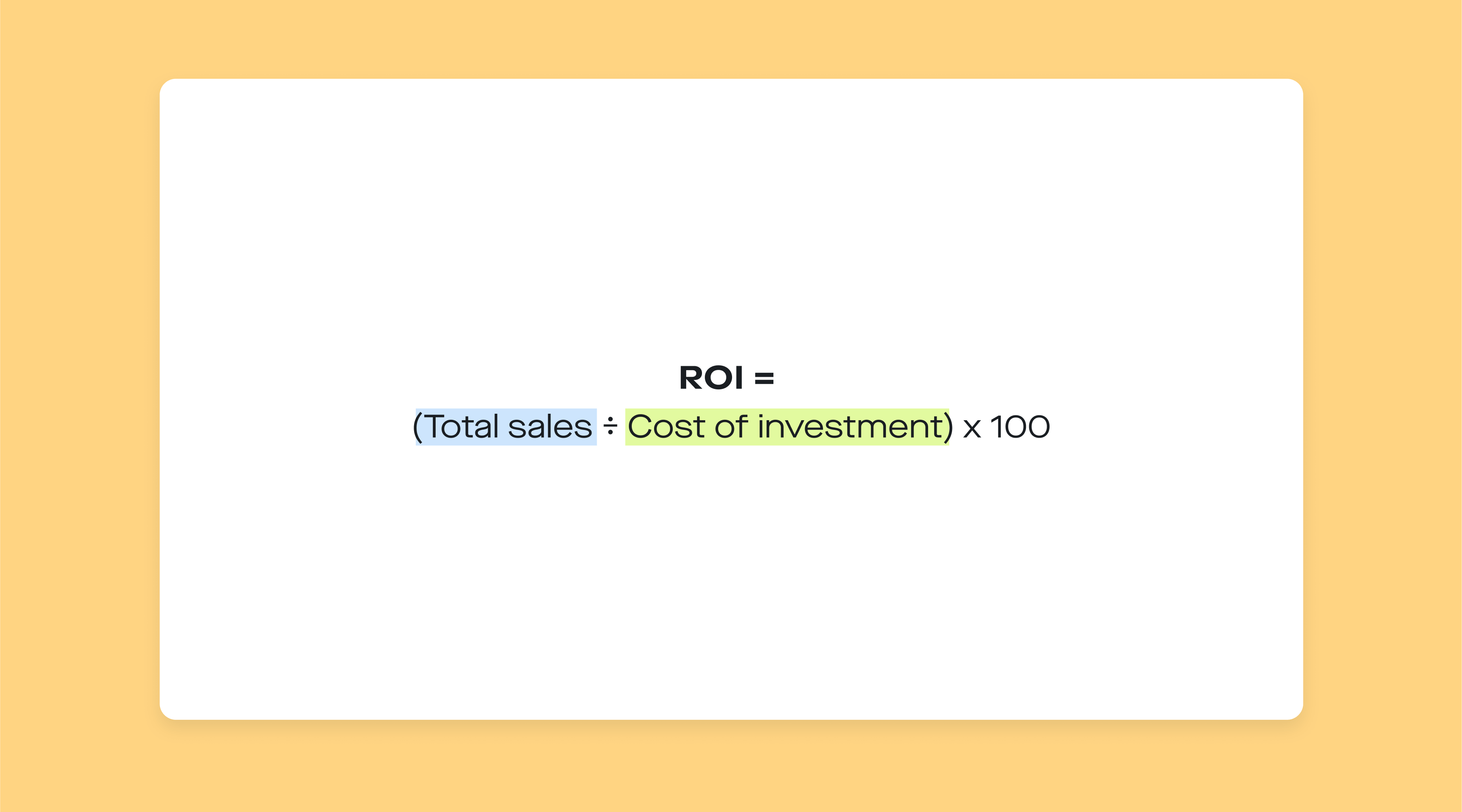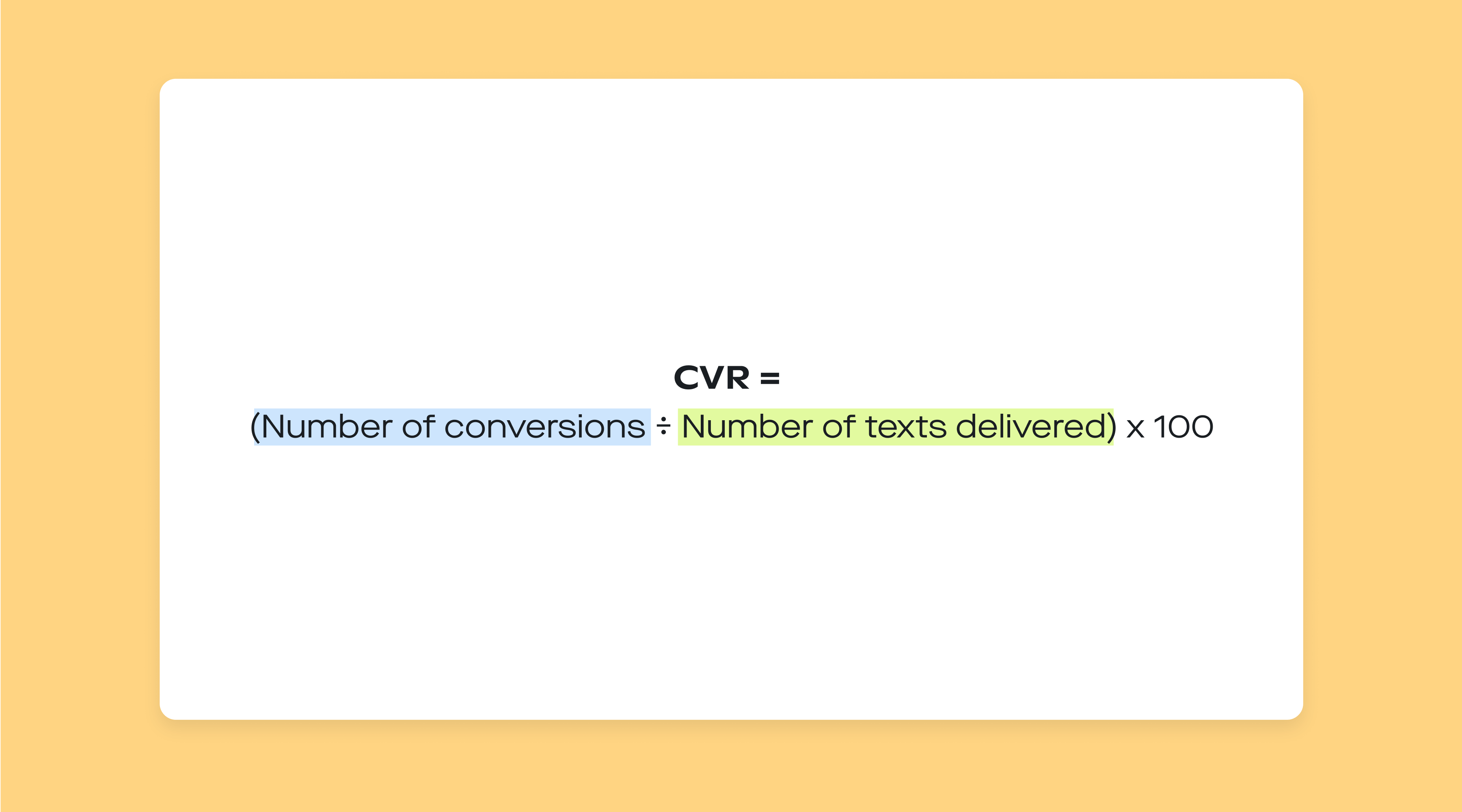
New releases
A smarter, simpler Attentive
Explore new features →
Explore new features →

Growing your SMS program without measuring your channel’s success is a bit like walking around in the dark. Metrics should be the north star of your brand’s SMS program, whether you’re creating an overall strategy or identifying areas of expansion and optimization.
Put simply by marketing expert Seth Godin, “Good marketers measure.”
Tracking your program’s performance will help you make informed decisions. It's especially important when you're working with a specific budget or resource constraints so you can maximize your impact and focus on the right things at the right time.

And sharing your channel’s success is just as important. Use our SMS Performance Overview Report template to share your SMS program’s performance with your team to highlight wins, implement learnings across channels, and make the case for more resources, if needed.
KPIs are a set of goals and metrics that help you measure your program’s impact.
SMS marketing KPIs usually fall into three buckets:
Ultimately, SMS KPIs help you make more informed decisions about where to spend your time and resources. By digging into your data, you can quantify the impact SMS has on your brand, spot opportunities for optimization, and decide what initiatives you want to invest in.
It's important to note your SMS marketing KPIs should complement the goals you set on your other channels (including email, loyalty, and push). For example, if email is an acquisition channel and SMS is a loyalty channel for your brand, think about how you can set different KPIs that reflect the customer lifecycle.
Some of these metrics may even overlap: Analyze how much lift you’re driving by adding SMS to your mix, and whether adding the extra touchpoint is increasing the revenue you drive through digital channels. You could also look at how you’ve grown your overall audience, including email and SMS subscribers.
Your KPIs should ladder up to your company’s goals to make sure you’re focusing on high-impact initiatives and optimizations. For example: If your brand is focused on acquiring new customers, you’ll want to measure:
But if you’re focused on increasing loyalty and retention, your metrics will look a little different:
Now, let’s dig into some of the KPIs you can use to measure your program’s success at both a high and a granular level.
Growing your list is a major part of your SMS program’s long-term success. The more subscribers you have, the more you’ll be able to nurture brand loyalists and drive revenue. List growth is also a strong marker for measuring your customer acquisition and retention efforts. You don’t want to just gain new subscribers. You want to keep the ones you already have engaged.
Primary metric: Month-over-month subscriber growth
How to measure it: List growth rate = ([Number of new subscribers) - (Number of unsubscribes)] / Previous month’s total number of subscribers]) x 100

Why does it matter? This metric will help you measure the impact of your overall list growth strategy—from the sign-up unit incentives that are driving conversions to where your subscribers are opting in. If your list growth slows down, it may be an indicator your incentives aren’t enticing new subscribers, it’s time to add new sign-up unit types (e.g., Spin-to-Win pop-ups and social landing pages), or that shoppers are opting out of your program at higher rates.
What does it look like in action? When global fashion brand Rebecca Minkoff saw over 80% of their site traffic come from mobile, they knew they had an opportunity to capture new subscribers shopping on their phones. The brand launched Attentive’s 2-in-1 sign-up units to convert browsers into SMS and email subscribers in a single flow. And using Attentive’s integration with Shopify, they also invite shoppers to sign up for texts as they’re checking out.
Their strategy paid off: Rebecca Minkoff beat the quarterly subscriber goal they set in under a month. Since then, the brand has maintained a strong list growth rate, increasing their subscriber list by 98.7% year-over-year.
Supplementary metrics:
Keeping tabs on the revenue you’re driving with SMS—especially your ROI or ROAS—is key to measuring your program’s success and making sure your messaging is resonating.
It’s important to take a holistic look at your SMS revenue. But to get a full picture of your channel’s impact on the customer lifecycle, you need to break revenue down by different message types (e.g., campaign messages vs. triggered messages) and campaign types (e.g., a seasonal campaign vs. a product launch announcement).
Your brand’s broader goals will also determine how you evaluate revenue. If you’re focused on retention, for example, revenue driven through your welcome series may not be the most accurate metric. Instead, maybe you’d want to look at whether you’re driving repeat revenue through your triggered post-purchase messages.
Primary metric: Return on Investment (ROI)
How to measure it: ROI = (Total sales / cost of investment) x 100

Why does it matter? ROI proves that SMS is adding incremental value to your marketing mix. It captures the tangible impact SMS has on your brand’s bottom line—the metric your leadership will likely care most about. And since SMS is a high-ROI channel, it’s also a great metric for you to use to make the business case for increasing (or continuing) your investment in SMS.
What does it look like in action? Performance footwear brand APL launched their SMS program with the goal of recreating the luxury in-store experience for mobile shoppers. They built a curated, high-touch SMS program to build loyalty and drive action around their product drops. From welcome journeys to browse-abandonment reminders, APL launched personalized journeys to engage shoppers across the customer lifecycle. Each message is tailored to individual shoppers’ intent, offering incentives to only those who are most likely to convert.
More than two years later, their investment has paid off: Their SMS program drives a 78x ROI, and 25% of subscribers have made three or more purchases.
Supplementary metrics:
Triggered revenue:
Drilling down into triggered message revenue will help you boost conversions. It can also help you identify the gaps in the customer lifecycle you can fill with SMS.
SMS Pro Tip: Track your incremental revenue growth to evaluate new strategies (e.g., sending a “final hours” reminder about a seasonal offer), triggered messages, and features (including conversational messaging and Text-to-Buy).
Measuring message engagement gives you direct insight into your audience’s needs and preferences. By keeping a pulse on your message engagement across your channel (including campaign, triggered, transactional, and conversational messages), you’re able to create more targeted messaging, identify and solve for drop-off points in the customer journey, and ultimately increase revenue and loyalty.
One thing to note: Not all messages are measured equally. If your top-line goal is increasing loyalty, measuring message CVRs may not be the most accurate marker of success. Because you’re probably weaving in non-promotional and brand-building messages, instead focus on how these messages help increase your audience of engaged subscribers. For example: Does sending a series of nurture campaigns lead to a lift in CTRs and CVRs when you announce new products or offers?
Primary metric: CVR
How to measure it: CVR = (Number of conversions / Number of texts delivered) x 100

Why does it matter? Think about your conversion rate as a message-level ROI evaluation. Your CVR will help you understand whether the revenue you drive makes up for your investment, or if there’s an opportunity to tweak your messages to maximize sales.
“Conversion rates are easily one of the most important things to track to ensure the success of your marketing campaigns—and stop you from wasting your budget.”
- Neil Patel
It’s important to benchmark your CVRs against similar messages to accurately measure performance over time. For example, a product launch campaign message will drive a different type of engagement compared to a seasonal offer announcement. The same goes for your triggered messages—your shoppers are in a different mindset when they’re entering your welcome journey compared to when they’ve left an item in their online shopping cart.
You should also consider breaking out performance based on the segments subscribers are in. Your unengaged subscriber segment will naturally engage with your messages at a lower rate compared to your VIPs. Benchmarking messages tailored to those unengaged subscribers will help you identify the messaging that resonates most with that target audience.
It's important to benchmark your CVRs against similar campaign types (e.g., breaking out a product launch vs. a seasonal offer), triggered message types, and conversation types (e.g., are you welcoming a new subscriber or helping a shopper who abandoned their shopping cart?).
What does it look like in action? Lifestyle brand Jenni Kayne and their sister skincare brand, Oak Essentials, launched their SMS program with Attentive to personalize mobile shoppers’ experiences. The brand leans into geo-targeting to send tailored invites and recommendations to subscribers based on where they live, and also personalizes messages based on whether a shopper has made a purchase before.
Both brands see an average 70% conversion rate on their triggered welcome journeys. Oak Essentials has seen particularly impressive performance: Their campaign messages see an average 25% CVR, their browse abandonment reminders drive an average 33% CVR, and their cart abandonment nudges achieve a whopping 73% average CVR.
SMS Pro Tip: Use Google Analytics (or other web tools) to measure the average amount of time it takes for a new subscriber to convert. This information can help you build thoughtful segments, optimize your welcome journeys, and nurture campaigns to decrease the time it takes to convert a new subscriber.
We recommend checking SMS metrics weekly when you launch a new campaign or triggered message to inform campaign planning and rolling edits. For your tried-and-true initiatives, we recommend digging into your numbers monthly. Finally, you should perform a quarterly business review (QBR) to measure your success against your team’s annual goals.
SMS Pro Tip: Continuously A/B test your SMS campaign messages and journeys to find the messaging that most resonates with your audience, identify areas for improvement, and unlock new engagement.
QBRs are your opportunity to highlight wins, share learnings, and realign your team around top-priority goals. Your CSM will review core metrics and learnings with you quarterly. If you're working independently, or want to do a quick check-in on the fly, you can use our SMS reporting template to share high-level metrics.
Whether you’re meeting with your CSM or your internal team, come prepared with these questions to spark discussion:
Less can be more when it comes to SMS marketing metrics. Prioritizing a few key metrics will help you measure your channels’ overall health, and how you’re performing against your goals. The metrics you track should ladder up to your brand’s broader goals. Doing so will make sure you’re never missing an opportunity to maximize your text message marketing program. Your CSM should be your partner in this—reach out to them to set your marketing KPIs and get help crafting an expert SMS strategy that will help you reach your goals.
Benchmarked your text messaging engagement and curious about how to increase your SMS conversion rate? Check out our guide to increasing your SMS conversion rates, so you can do more with less.